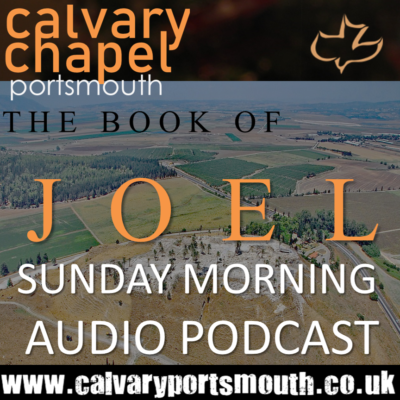This teaching on Joel chapter 2 was given by pastor Barry Forder at Calvary Chapel Portsmouth on 26th September 2021.
Last week we saw how God used the real plague of locusts in Joel’s time to warn the nation of Israel, and ‘all who have ears to hear’, that another devastating judgment is coming on Israel, and indeed upon the whole earth.
Hosea tells us that God uses similitudes (models or types) to speak to us. We know that the Feasts of Israel, as well as being literal, historical events, were also given as anticipatory models of things that would come later. Last week we noted that the first four feasts of Israel find their prophetic fulfilment in the death, burial and resurrection of Jesus and the birth (and possibly the subsequent rapture) of the Church.
This leaves us with the last three feasts, the Feast of Trumpets, the Feast of Atonement and the Feast of Tabernacles for which no prophetic fulfilment has yet taken place. It would seem from scripture that these last three feasts are specifically linked to events that will befall the nation of Israel; moreover it appears that the book of Joel becomes a model of the prophetic fulfilment of these feasts.
Remember that Joel seems to have been the first of the ‘writing’ prophets; before Isaiah, Hosea or any of the prophets who would come later and add more ‘colour’ to the outline Joel gives us.
Montague S. Mills said: “Joel, … was probably the first of the so called writing prophets; so this book provides a valuable insight into the history of prophecy, particularly as it furnishes a framework for the end times which is faithfully followed by all subsequent Scripture. God started a new work with the writing of Joel, that of preparing the human race for the end of this temporal era, and thus gave an outline of His total plan. Later prophets, including even our Lord, would only flesh out this outline, but in keeping with the divine nature of true Scripture, never found it necessary to deviate from this, the initial revelation.”
The first chapter of Joel, as we studied last week, seems to give the prophetic summery of the nations history from the time of the Exodus (the Birth of the Nation of Israel), to the time of the Tribulation (still yet future).
Prophetically, chapter 1 seems to unveil:
- Verse 1: Introduction: God speaks! – who will listen?
- Verse 2-3: Riches to rags! – How Israel went from being betrothed & blessed by God to being cast out of their land and made to wander throughout the world.
- Verse 4: Utter destruction – the literal Locust plague the Joel witnessed as a forerunner of a far more deadly and destructive plague that is yet to come.
- Verse 5: Israel’s wake-up call! – Israel we given countless chances to return and walk with God and avoid judgment….
- Verse 6-7: Rome! – but alas, because of the Israel’s disobedience, God allowed nations to conquer and subdue them, most notably Rome!
- Verse 8: Israel’s rejection of Messiah – rather than Israel’s betrothal leading to bliss, Israel rejected and killed their Messiah.
- Verse 9: AD 70 – Sacrifice stopped – consequently, what Jesus warned in Like 19 came upon them.
- Verse 10: AD 132 – Jerusalem ploughed – by Emperor Hadrian who wanted the Jews expelled from the Land of Israel.
- Verse 11-12: Worldwide diaspora & shame – history is our record.
- Verse 13: Abomination of Desolation! Sacrifice ‘withholden’ Time to flee! Jesus spoke of this in Matthew 24 etc. and warned this time would come
- Verse 14: The ‘Elders’ gathered into the house of the LORD & called to pray! ‒A picture of the Rapture of the Church and our subsequent obligation?
- Verse 15: The Day of The LORD The Great Tribulation begins!
- Verse 16-18: Israel forced to flee
- Verse 19-20: Desperate Israel seeks refuge in the wilderness of Edom – these last 3 points will now be expounded in chapter 2
In chapter 2 we start to see the prophetic fulfilment of the Feast of Trumpets and the Feast of Atonement:
The Feast of Trumpets (Joel 1:1 – 2:11)
Having already laboured the point that every detail is in the Bible for a reason, it is very likely that the Feast of Trumpets will have its fulfilment during the trumpet judgments of Revelation 8-9. According to Joel 1:1-2:11 these judgments will have a specific impact on the nation of Israel and must occur during the first half of the 7 year Tribulation period while Israel are still in their land and before they flee into the wilderness to escape Antichrist at the 3 1/2 year point. The two key elements of the Feast of Trumpets as detailed in Leviticus 23 are a blowing of trumpets and an ‘offering made by fire’. In Revelation 8-9 and Joel 1:1 – 2:11 we have trumpets blown, and we know that fire is emblematic of judgment, exactly what is happening to Israel during the Tribulation.
The Feast of Atonement (Joel 2:12 – 32)
In verse 12 of Joel chapter 2 the mood changes and Israel are called to repentance. In verses 15-17 a trumpet is blown in Zion. Could this be heaven with the elders (the Bride) and the great multitude serving before the alter (see Rev 6: 9 / Rev 7:15) being called to intercede for Israel so that she be not overwhelmed by her enemies? In verses 18-19 God answers and promises to provide ‘oil and wine’ for them. Clearly this is dealing with the time that Jesus spoke about in Matthew 24:15-22 when Antichrist will erect his statue (the Abomination of Desolation) in the temple in Jerusalem and Israel will flee for her life into the wilderness to ‘a place prepared for her by God’ (Rev 12:6) for the last 3 1/2 years of Daniel’s 70th week. During this time, she will be supernaturally provided for by God (Rev 12:14).
The Feast of Atonement as recorded in Leviticus 23 is a time of reconciliation to God and Joel 2:20-32 again details this time when Israel will return to the Lord their God. This is also prophesied in Hosea 5:15-6:2.
It is interesting that, as we saw in Luke 19, blindness was pronounced upon Israel because they did not know the ‘time of their visitation’. Paul explains in Romans 11:25 that this blindness will last ‘until the fullness of the Gentiles are gathered in’. Many scholars have wondered when this will occur, but surely it will be at this point during the Tribulation when significantly, the last of the martyrs (Gentiles) from the tribulation are killed for not receiving the mark of the beast. Thus ‘the fullness of the Gentiles will be gathered in’ and Israel’s blindness will be removed.
One final observation that suggests a link with this period of time and the Feast of Atonement is found in Leviticus 16, which gives the specific instructions for the Day of Atonement. What is significant is that there are two goats that are to be presented, one is sacrificed: “Then shall he kill the goat of the sin offering, that is for the people, and bring his blood within the veil, and do with that blood as he did with the blood of the bullock, and sprinkle it upon the mercy seat, and before the mercy seat” (Lev 16:15) – this is symbolic of Christ’s death when the veil separating man from God was torn in two (Matt 27:51 / Heb10:20). The other goat is the scapegoat which three times (v10, v21 & v22) we are told is to escape into the wilderness and specifically “unto a land not inhabited: and he shall let go the goat in the wilderness”. (Lev 16:22).
Finally, commenting on the verse in Leviticus 23:27, bible scholar C.I. Scofield says: “…here the stress is laid upon the sorrow and repentance of Israel. That is, the prophetic feature is made prominent, looking forward to the repentance of Israel after their regathering under the Palestinian covenant (Deut 30:1-10) preparatory to the second advent of Messiah and the establishment of the kingdom. See the connection between the trumpet in Joel 2:1 and the mourning which follows in verse 11-15.”
Next week we will conclude this study and consider Joel ch3: Armageddon, the Return of Jesus Christ and The Feast of Tabernacles
May you be encouraged to study and walk in the Word of God!


